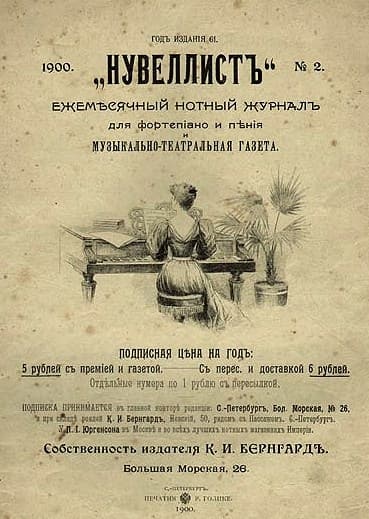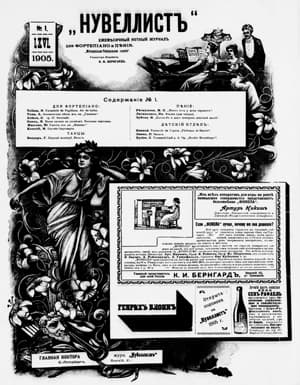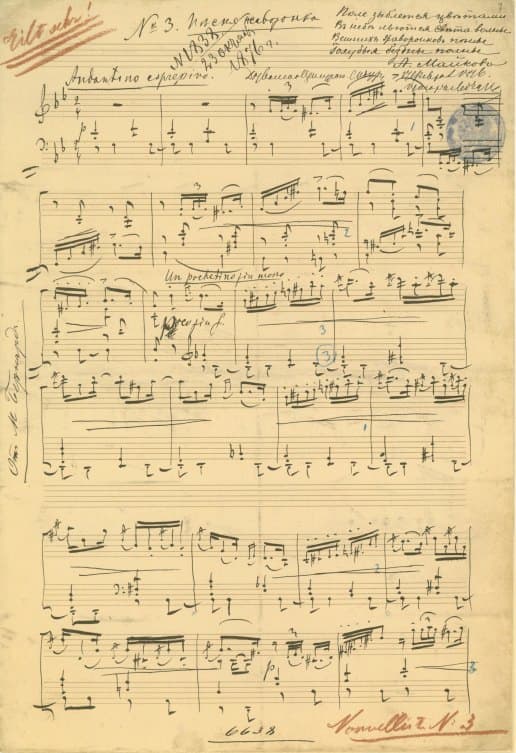The First Piano Concerto by Pyotr Ilyich Tchaikovsky (1840-1893) is one of the most popular concertos ever written. But it is not a piece for the faint-hearted. It makes huge technical demands on the performer, and because of its dramatic and emotional qualities, it ranks among the most difficult piano concertos on the planet. Performances are better left to real professionals.
Buniatishvili/Mäkelä Perform Tchaikovsky’s Piano Concerto No. 1 in B-flat minor, Op. 23
Luckily for most of us, Tchaikovsky also wrote piano pieces for the amateur market. And among his most popular are The Seasons, subtitled “12 Characteristic Scenes.” One doesn’t need massive technical skills, but with a bit of perseverance and sensitivity any competent pianist can readily identify with the lyricism and the moods of the music.

Pyotr Ilyich Tchaikovsky
The collection of twelve piano pieces that make up The Seasons dates from around the time when Tchaikovsky was finishing Swan Lake. He was approached by the publisher Nikolai Bernard, the editor of the Petersburg journal Nuvellist, at the end of 1875. The commission was to compose a series of piano pieces to appear in the journal’s monthly instalments.
Pyotr Ilyich Tchaikovsky: The Seasons, Op. 37a, “January: By the Fireside” (Galina Petrova, piano)
The reason Tchaikovsky agreed to the commission is really simple; he badly needed money. As the composer writes, “I am most grateful for your courtesy and readiness to pay me such a high fee. I shall send you the first piece shortly, and perhaps the next two or three, as I am at the moment very much in the mood for piano pieces.”
It seems that Tchaikovsky wasn’t in the mood all the time, and a funny anecdote suggests that Tchaikovsky instructed his servant to remind him of his duty on a certain day in the month. Apparently, Tchaikovsky composed each piece at a singling sitting, “and he attached very little importance to them.” Lucky for us, The Seasons became some of Tchaikovsky’s best-known music for solo piano, and the whole collection has been orchestrated, transcribed, and arranged countless times.
Pyotr Ilyich Tchaikovsky: The Seasons, Op. 37a, “February: Carnival” (Mikhail Pletnev, piano)

The Nuvellist Journal cover
The commission was also a sign of the times. Russia was gradually modernizing, and a growing middle class continued to copy the bourgeois habits of the West. And that meant much listening to classical music, singing and playing the piano. And the middle class might well have a subscription to the musical-theatrical journal Nuvellist, and you would get to try out an original composition by Tchaikovsky every month.
To make the compositions even more attractive, Tchaikovsky and Bernard agreed that each piece in The Seasons would have its own title, and be headed by an epigraph. And Bernard announced the upcoming series in bold type on the cover of the December 1875 issue. “Our celebrated composer P. I. Tchaikovsky has promised the editor of Nuvellist, that he will contribute to next year’s issue a whole series of piano compositions, specially written for our journal, the character of which will correspond entirely to the titles of the pieces, and the month in which they will be published in the journal.”
Pyotr Ilyich Tchaikovsky: The Seasons, Op. 37a, “March: Song of the Lark” (Lydia Artymiw, piano)
Possibly, both Bernard and Tchaikovsky had a say in the choice of texts that matched words to the music or the other way around. At any rate, “January: By the fireside” was prefaced by a verse by Aleksandr Pushkin:
A little corner of peaceful bliss
The night dressed in twilight;
The little fire is dying in the fireplace,
And the candle has burned out.
Tchaikovsky was rather dismissive about the project as a whole, but nothing in the music suggests anything trivial. In fact, the middle section of “January” was used to build Tatyana’s letter scene from his operatic masterpiece Yevgeny Onegin in 1877.
Pyotr Ilyich Tchaikovsky: The Seasons, Op. 37a, “April: Snowdrop” (Elena Ivanina, piano)
“February: The Carnival” is prefaced by two lines from Pavel Vyazemsky:
At the lively Mardi Gras
Soon a large feast will overflow.

The Nuvellist Journal
While “January” sounded a rather intimate miniature, February bursts forth with the extravagance of “Carnival.” This most important time of year, which we also know as the “Shrovetide Fair,” from a later setting in Stravinsky’s Petrushka, sounds music evoking the hustle and bustle of the crowds with various attractions and vendors competing for attentions. And while I don’t hear the dancing bears, there seems a hint of competing accordions in Tchaikovsky’s setting.
Pyotr Ilyich Tchaikovsky: The Seasons, Op. 37a, “May: May Nights” (Sviatoslav Richter, piano)
“The Song of the Lark” in March is introduced by poetic lines by Apollon Maykov:
The field shimmering with flowers,
The stars swirling in the heavens,
The song of the lark fills the blue abyss.
The music here returns to a far more private and expressive world. Quiet and pensive, it is a melancholy miniature with the suggestion of birdsong indicated by a pecking staccato touch. March is still a cold month, and the broad and spacious music seems to come from a distant realm.
Pyotr Ilyich Tchaikovsky: The Seasons, Op. 37a, “June: Barcarolle” (Fazıl Say, piano)
Another poetic inscription by Apollon Maykov heads “April: Snowdrop.”
The blue, pure snowdrop-flower,
And near it the last snowdrops.
The last tears over past griefs,
And first dreams of another happiness.

Pyotr Ilyich Tchaikovsky: The Seasons music score
While we are still technically in winter season, the “Snowdrop” actually refers to a genus of perennial flower. Just as the poem talks about endings and new beginnings, so does the music combine tender melancholy and delicate moments in a beautiful spirited way.
Pyotr Ilyich Tchaikovsky: The Seasons, Op. 37a, “July: Song of the Reaper” (Kalle Randalu, piano)
The poetic verse by the famous Russian poet Afanasy Fet heads “May: White Nights.”
What a night! What bliss is all about!
I thank my native north country!
From the kingdom of ice and snow,
How fresh and clean May flies in!
Twinkling stars stretch across a beautiful night sky, and cool breezes from the North are reminding the listener that winter has moved into the distance. However, the joyfulness of the coming spring is beautifully evoked in the music.
Pyotr Ilyich Tchaikovsky: The Seasons, Op. 37a, “August: The Harvest” (Yefim Bronfman, piano)
The “Barcarolle” of June is probably the most famous piece of the set, and the poetic introduction is provided by Aleksey Pleshcheyev:
Let us go to the shore;
There the waves will kiss our legs.
With mysterious sadness
The stars will shine down on us.
This gentle and lyrical melody does not really evoke the undulating movement of Venetian gondolas, but it is one of the most endearing piano miniatures ever written. July’s “Reaper song” sounds a more inward tone, but it is nevertheless set outdoors as the poem speaks of “the noon wind breathes in the face!”
Pyotr Ilyich Tchaikovsky: The Seasons, Op. 37a, “September: The Hunt” (Barry Douglas, piano)
Aleksey Koltsov’s poetic and very practical lines head the miniature titled “August: The Harvest:”
The harvest has grown,
People in families cutting the tall rye
Down to its roots!
Put together the haystacks,
Music screeching all night
From the hauling carts.
Technically, the music gets a bit more complicated in August, as the accompaniment suggests a Mendelssohn scherzo. It’s also difficult to find a wide range of colours in the musical stream that seems anxious to get the harvest secured before the arrival of the September rains. Unsurprisingly, the “Hunt” in September to another verse from Pushkin sounds the distinct horn calls in the beginning.
Pyotr Ilyich Tchaikovsky: The Seasons, Op. 37a, “October: Autumn Song” (Myung-Whun Chung, piano)
In his October “Autumn Song,” Tchaikovsky returns to a more poetic contemplation. One of the melancholiest episodes in the set, this extended miniature mirrors the sighing lines of Aleksey Tolstoy.
The autumn, falling on our poor orchard,
The yellow leaves are flying in the wind.
Pyotr Ilyich Tchaikovsky: The Seasons, Op. 37a, “November: Troika” (Valentina Lisitsa, piano)
November it titled after the three-horsed Russian sleigh called “Troika.” The poetic introduction is by Nikolay Nekrasov, and apparently it was a movement that Rachmaninoff loved to play.
In your loneliness do not look at the road,
And do not rush out after the troika.
Suppress at once and forever
The fear of longing in your heart.
Finally we arrive at “December” and a piece aptly titled “Christmas.” The poem describes young girls taking off their slippers at the gate, a custom related to a local fortune-telling tradition. Tchaikovsky ends The Seasons with a beautifully engaging waltz. This gorgeous set finds Tchaikovsky at his most lyrical and, at least for amateur pianists, at his most approachable.
Pyotr Ilyich Tchaikovsky: The Seasons, Op. 37a, “December: Christmas” (Eleonora Karpukhova, piano)
For more of the best in classical music, sign up for our E-Newsletter

